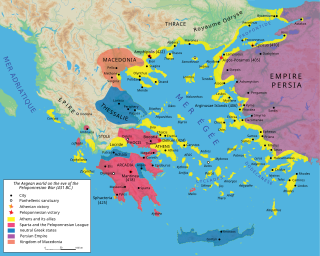
The Delian League was a confederacy of Greek city-states, numbering between 150 and 330, founded in 478 BC under the leadership (hegemony) of Athens, whose purpose was to continue fighting the Persian Empire after the Greek victory in the Battle of Plataea at the end of the Second Persian invasion of Greece. The League functioned as a dual –offensive and defensive– alliance (symmachia) of autonomous states, similar to its rival association, the Peloponnesian League.

The Peloponnesian War was an ancient Greek war fought between Athens and Sparta and their respective allies for the hegemony of the Greek world. The war remained undecided for a long time, until the decisive intervention of the Persian Empire in support of Sparta. Led by Lysander, the Spartan fleet, built with Persian subsidies, finally defeated Athens and started a period of Spartan hegemony over Greece.
This article concerns the period 469 BC – 460 BC.

Nicias was an Athenian politician and general during the period of the Peloponnesian War. Nicias was a member of the Athenian aristocracy and had inherited a large fortune from his father, which was invested in the silver mines around Attica's Mt. Laurium. Following the death of Pericles in 429 BC, he became the principal rival of Cleon and the democrats in the struggle for the political leadership of the Athenian state. He was a moderate in his political views and opposed the aggressive imperialism of the democrats. His principal aim was to conclude a peace with Sparta as soon as it could be obtained on terms favourable to Athens.
The Peace of Callias is a purported peace treaty that supposedly was established around 449 BC between the Delian League and the Achaemenid Empire and ended the Greco-Persian Wars. The peace would then be the first compromise treaty between Achaemenid Persia and a Greek city.
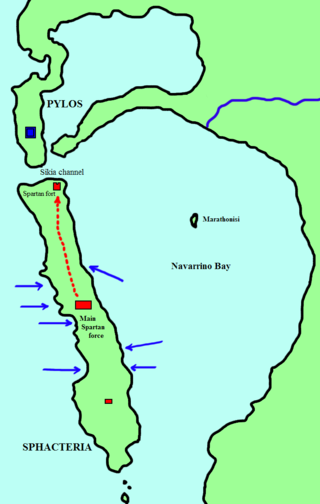
The Battle of Sphacteria was a land battle of the Peloponnesian War, fought in 425 BC between Athens and Sparta. Following the Battle of Pylos and subsequent peace negotiations, which failed, a number of Spartans were stranded on the island of Sphacteria. An Athenian force under Cleon and Demosthenes attacked and forced them to surrender.
Pleistoanax, also spelled Plistoanax, was Agiad king of Sparta from 458 to 409 BC. He was the leader of the peace party in Sparta at a time of violent confrontations against Athens for the hegemony over Greece.
The Megarian Decree was a set of economic sanctions levied upon Megara c. 432 BC by the Athenian Empire shortly before the outbreak of the Peloponnesian War. This move is considered one of the first uses of economics as a foreign policy tool. The decree addressed the Megarians' supposed trespass on land sacred to Demeter known as the Hiera Orgas, the killing of the Athenian herald who was sent to their city to reproach them, and giving shelter to slaves who had fled from Athens. The Megarian decree effectively blocked Megara from trading in any port within the Delian League, isolating the city and greatly damaging its economy. The exact influence the Megarian Decree had on the beginning of the Peloponnesian War is a matter that is highly debated to this day.
Hegetorides was a citizen of the Greek island of Thasos during the Peloponnesian War between Athens and Sparta, mentioned by the 2nd-century historian Polyaenus. Lemprière's Classical Dictionary claims that when Hegetorides saw that his city was besieged by Athenian forces and that there was a law declaring death to anyone who spoke of peace, he went into the agora with a rope tied around his neck. He told his fellow citizens to do whatever they wished with him, provided that they saved the city from the starvation and death that the continued war promised. The Thasians were shocked from their determination, sued for peace, and pardoned Hegetorides.
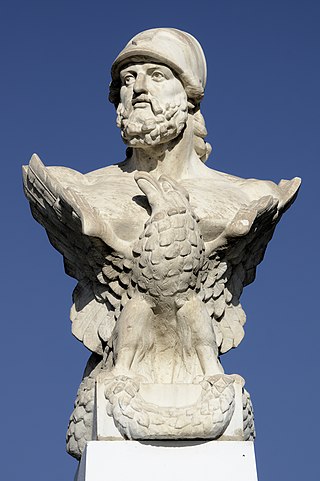
Cimon or Kimon was an Athenian strategos and politician.

Eion, ancient Chrysopolis, was an ancient Greek Eretrian colony in Thracian Macedonia specifically in the region of Edonis. It sat at the mouth of the Strymon River which flows into the Aegean from the interior of Thrace. It is referred to in Thucydides' History of the Peloponnesian War as a place of considerable strategic importance to the Athenians during the Peloponnesian War.
The siege of Melos occurred in 416 BC during the Peloponnesian War, which was a war fought between Athens and Sparta. Melos is an island in the Aegean Sea roughly 110 kilometres east of mainland Greece. Though the Melians had ancestral ties to Sparta, they were neutral in the war. Athens invaded Melos in the summer of 416 BC and demanded that the Melians surrender and pay tribute to Athens or face annihilation. The Melians refused, so the Athenians laid siege to their city. Melos surrendered in the winter, and the Athenians executed the men of Melos and enslaved the women and children.
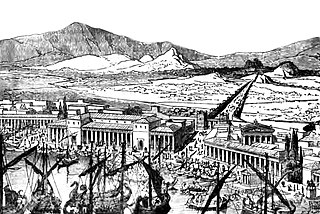
Although long walls were built at several locations in ancient Greece, notably Corinth and Megara, the term Long Walls generally refers to the walls that connected Athens' main city to its ports at Piraeus and Phaleron.

Pentecontaetia is the term used to refer to the period in Ancient Greek history between the defeat of the second Persian invasion of Greece at Plataea in 479 BC and the beginning of the Peloponnesian War in 431 BC. The term originated with a scholiast commenting on Thucydides, who used it in their description of the period. The Pentecontaetia was marked by the rise of Athens as the dominant state in the Greek world and by the rise of Athenian democracy, a period also known as Golden Age of Athens. Since Thucydides focused his account on these developments, the term is generally used when discussing developments in and involving Athens.

The Samian War was an Ancient Greek military conflict between Athens and Samos. The war was initiated by Athens's intervention in a dispute between Samos and Miletus. When the Samians refused to break off their attacks on Miletus as ordered, the Athenians easily drove out the oligarchic government of Samos and installed a garrison in the city, but the oligarchs soon returned, with Persian support.
The First Peloponnesian War was fought between Sparta as the leaders of the Peloponnesian League and Sparta's other allies, most notably Thebes, and the Delian League led by Athens with support from Argos. This war consisted of a series of conflicts and minor wars, such as the Second Sacred War. There were several causes for the war including the building of the Athenian long walls, Megara's defection and the envy and concern felt by Sparta at the growth of the Athenian Empire.
The Areopagite constitution is the modern name for a period in ancient Athens described by Aristotle in his Constitution of the Athenians. According to that work, the Athenian political scene was dominated, between the ostracism of Themistocles in the late 470s BC and the reforms of Ephialtes in 462 BC, by the Areopagus, a traditional court composed of former archons. Modern scholars have debated the existence of this phenomenon, with some concluding that Aristotle and his contemporaries invented it to explain Ephialtes' need to limit the Areopagus' powers, and arguing that the lack of concrete measures establishing the Areopagus' dominance shows that the Areopagite constitution is "palpably unhistorical". Other scholars, such as Donald Kagan, have countered that no concrete measures were necessary, as the Areopagus' dominance was established not through actual changes in the laws but through the prestige of its leading members. Aristotle specifically cites the Areopagites' distribution of money to the public as the citizen body prepared to abandon Athens in the face of the advancing Persian army.
The Mytilenean revolt was an incident in the Peloponnesian War in which the city of Mytilene attempted to unify the island of Lesbos under its control and revolt from the Athenian Empire. In 428 BC, the Mytilenean government planned a rebellion in concert with Sparta, Boeotia, and certain other cities on the island, and began preparing to revolt by fortifying the city and laying in supplies for a prolonged war. These preparations were interrupted by the Athenian fleet, which had been notified of the plot, and the Mytileneans sent representatives to Athens to discuss a settlement, but simultaneously dispatched a secret embassy to Sparta to request support.
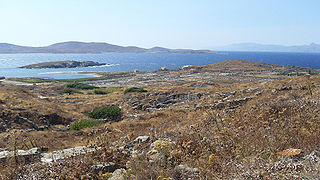
The Wars of the Delian League were a series of campaigns fought between the Delian League of Athens and her allies, and the Achaemenid Empire of Persia. These conflicts represent a continuation of the Greco-Persian Wars, after the Ionian Revolt and the first and second Persian invasions of Greece.
The 464 BC Spartan earthquake occurred along the Sparta fault in the year 464 BC destroying much of what was Sparta and many other city-states in ancient Greece. Historical sources suggest that the death toll may have been as high as 20,000, although modern scholars suggest that this figure is likely an exaggeration. The earthquake gave Spartan helots an opportunity to revolt against their aristocratic rulers, and the Athenians were called to their aid. Their immediate dismissal upon arrival is said to have been a key event that lead up to the First Peloponnesian War.










